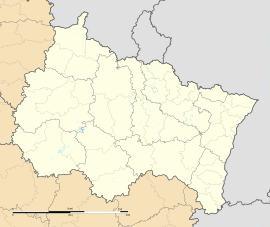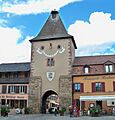Turckheim facts for kids
Quick facts for kids
Turckheim
|
||
|---|---|---|

Entrance to Turckheim through the Porte de France
|
||
|
||
| Country | France | |
| Region | Grand Est | |
| Department | Haut-Rhin | |
| Arrondissement | Colmar-Ribeauvillé | |
| Canton | Wintzenheim | |
| Intercommunality | Colmar Agglomération | |
| Area
1
|
16.46 km2 (6.36 sq mi) | |
| Population
(2021)
|
3,928 | |
| • Density | 238.64/km2 (618.07/sq mi) | |
| Time zone | UTC+01:00 (CET) | |
| • Summer (DST) | UTC+02:00 (CEST) | |
| INSEE/Postal code |
68338 /68230
|
|
| Elevation | 219–840 m (719–2,756 ft) (avg. 240 m or 790 ft) |
|
| 1 French Land Register data, which excludes lakes, ponds, glaciers > 1 km2 (0.386 sq mi or 247 acres) and river estuaries. | ||
|
Imperial City of Turckheim
|
|||||||||
|---|---|---|---|---|---|---|---|---|---|
| 1312–1648 | |||||||||
| Status | Free Imperial City of the Holy Roman Empire | ||||||||
| Capital | Turckheim | ||||||||
| Government | Republic | ||||||||
| Historical era | Middle Ages | ||||||||
|
• Gained Imp. immediacy
|
1312 | ||||||||
|
• Received city rights,
joined the Décapole |
1354 |
||||||||
| 24 October 1648 | |||||||||
26 January 1679 |
|||||||||
|
|||||||||
| Today part of | France | ||||||||
Turckheim is a charming town in north-eastern France. It is located in the Haut-Rhin department, which is part of the Grand Est region. You can find it west of Colmar, nestled on the eastern slopes of the Vosges mountains.
This historic town is known for its well-preserved medieval walls and its unique tradition of a night watchman. Turckheim offers a glimpse into the past with its rich history and beautiful scenery.
Contents
Exploring Turckheim's Past: A Journey Through Time
How Did Turckheim Get Its Name?
Long, long ago, during the time of Ancient Rome, people already lived in the area where Turckheim stands today. Later, Germanic tribes, like the Thuringii, moved in. It is believed that these Thuringii people gave the town its name.
At first, it was called Thorencohaime, and then Thuringheim. Over time, it changed to the name we know today: Turckheim.
Becoming a Free Imperial City
In 1312, Turckheim became a special place called a free imperial city. This meant it was directly under the rule of the Holy Roman Empire's emperor, not a local lord. This gave the town more freedom.
By 1315, people started building strong ramparts (defensive walls) around the town. These walls are still in great condition today!
Joining the Décapole League
Turckheim had important city rights and market rights by 1354. From that year until 1679, it was part of a group called the Décapole. This was a league of ten free imperial cities in the Holy Roman Empire.
After the Peace of Westphalia in 1648, which ended a big war, Turckheim and other towns in the Alsace region did not want to become part of France.
The Battle of Turckheim (1675)
During the Franco-Dutch War, French armies, led by Henri de La Tour d'Auvergne, Viscount of Turenne, took control of Turckheim. They then defeated armies from Austria and Brandenburg in a famous battle known as the Battle of Turckheim in 1675.
You can even see features of Turckheim, like its gates, on an old fan displayed at the Fan Museum in Greenwich, England! In 1678, the Treaties of Nijmegen were signed, and Turckheim officially became part of France.
Changes in Ownership: Germany and France
History continued to shape Turckheim. In 1871, after the Franco-Prussian War, the town, along with the rest of Alsace, became part of the German Empire. However, in 1918, after World War I, it returned to France.
The Night Watchman Tradition
Turckheim is one of the few towns in France that still has a municipal night watchman! This person walks around at 10 p.m. between May 1st and October 31st, and on the three Saturdays before Christmas.
This tradition is kept alive for tourists. It reminds everyone of a night watchman from the 13th century who saved the town from a fire.
Turckheim's Location and Weather
Where is Turckheim Located?
Turckheim is situated in the valley of the Fecht river. It is downstream from Munster. The town is about 6 kilometers (about 3.7 miles) west of the city center of Colmar.
What is Turckheim's Climate Like?
Turckheim has an oceanic climate, which means it has mild temperatures and rainfall throughout the year. The average yearly temperature is about 9.4 degrees Celsius (48.9 degrees Fahrenheit).
The town gets about 828.0 millimeters (32.6 inches) of rain each year, with December usually being the wettest month. July is typically the warmest month, with an average temperature of about 18.3 degrees Celsius (64.9 degrees Fahrenheit). January is the coldest, averaging around 1.2 degrees Celsius (34.2 degrees Fahrenheit).
The hottest temperature ever recorded in Turckheim was 35.7 degrees Celsius (96.3 degrees Fahrenheit) on August 7, 2015. The coldest was -20.0 degrees Celsius (-4.0 degrees Fahrenheit) on January 13, 1987.
| Climate data for Turckheim (1981–2010 averages, extremes 1986−present) | |||||||||||||
|---|---|---|---|---|---|---|---|---|---|---|---|---|---|
| Month | Jan | Feb | Mar | Apr | May | Jun | Jul | Aug | Sep | Oct | Nov | Dec | Year |
| Record high °C (°F) | 17.7 (63.9) |
19.4 (66.9) |
23.5 (74.3) |
26.0 (78.8) |
30.9 (87.6) |
34.5 (94.1) |
35.5 (95.9) |
35.7 (96.3) |
30.4 (86.7) |
26.4 (79.5) |
19.2 (66.6) |
18.6 (65.5) |
35.7 (96.3) |
| Mean daily maximum °C (°F) | 3.8 (38.8) |
4.7 (40.5) |
8.1 (46.6) |
12.1 (53.8) |
17.0 (62.6) |
20.1 (68.2) |
22.3 (72.1) |
22.2 (72.0) |
17.5 (63.5) |
13.0 (55.4) |
7.4 (45.3) |
4.1 (39.4) |
12.7 (54.9) |
| Daily mean °C (°F) | 1.2 (34.2) |
1.9 (35.4) |
5.0 (41.0) |
8.4 (47.1) |
13.1 (55.6) |
16.1 (61.0) |
18.3 (64.9) |
18.3 (64.9) |
14.0 (57.2) |
10.1 (50.2) |
4.8 (40.6) |
1.7 (35.1) |
9.4 (48.9) |
| Mean daily minimum °C (°F) | −1.5 (29.3) |
−0.9 (30.4) |
1.9 (35.4) |
4.7 (40.5) |
9.2 (48.6) |
12.2 (54.0) |
14.3 (57.7) |
14.3 (57.7) |
10.6 (51.1) |
7.1 (44.8) |
2.3 (36.1) |
−0.6 (30.9) |
6.2 (43.2) |
| Record low °C (°F) | −20.0 (−4.0) |
−17.4 (0.7) |
−13.5 (7.7) |
−7.0 (19.4) |
−0.5 (31.1) |
3.2 (37.8) |
6.3 (43.3) |
6.2 (43.2) |
2.5 (36.5) |
−4.2 (24.4) |
−11.7 (10.9) |
−17.1 (1.2) |
−20.0 (−4.0) |
| Average precipitation mm (inches) | 65.4 (2.57) |
65.0 (2.56) |
63.0 (2.48) |
54.3 (2.14) |
79.8 (3.14) |
69.7 (2.74) |
75.0 (2.95) |
67.6 (2.66) |
65.2 (2.57) |
81.0 (3.19) |
60.6 (2.39) |
81.4 (3.20) |
828.0 (32.60) |
| Average precipitation days (≥ 1.0 mm) | 9.9 | 10.1 | 10.5 | 10.5 | 12.0 | 10.9 | 10.9 | 10.1 | 9.2 | 10.4 | 10.6 | 10.9 | 126.1 |
| Source: Météo France | |||||||||||||
How Many People Live in Turckheim?
The number of people living in Turckheim has changed over the years. Here's a look at the population at different times:
- 1968: 3,028 people
- 1975: 3,609 people
- 1982: 3,510 people
- 1990: 3,567 people
- 1999: 3,594 people
- 2007: 3,731 people
- 2012: 3,723 people
- 2017: 3,776 people
Famous People from Turckheim
- Victor Sieg (1837 – 1899) was a composer and organist. He was born in Turckheim. There is a street named Rue Victor Sieg in his honor.
See also
 In Spanish: Turckheim para niños
In Spanish: Turckheim para niños
Images for kids






